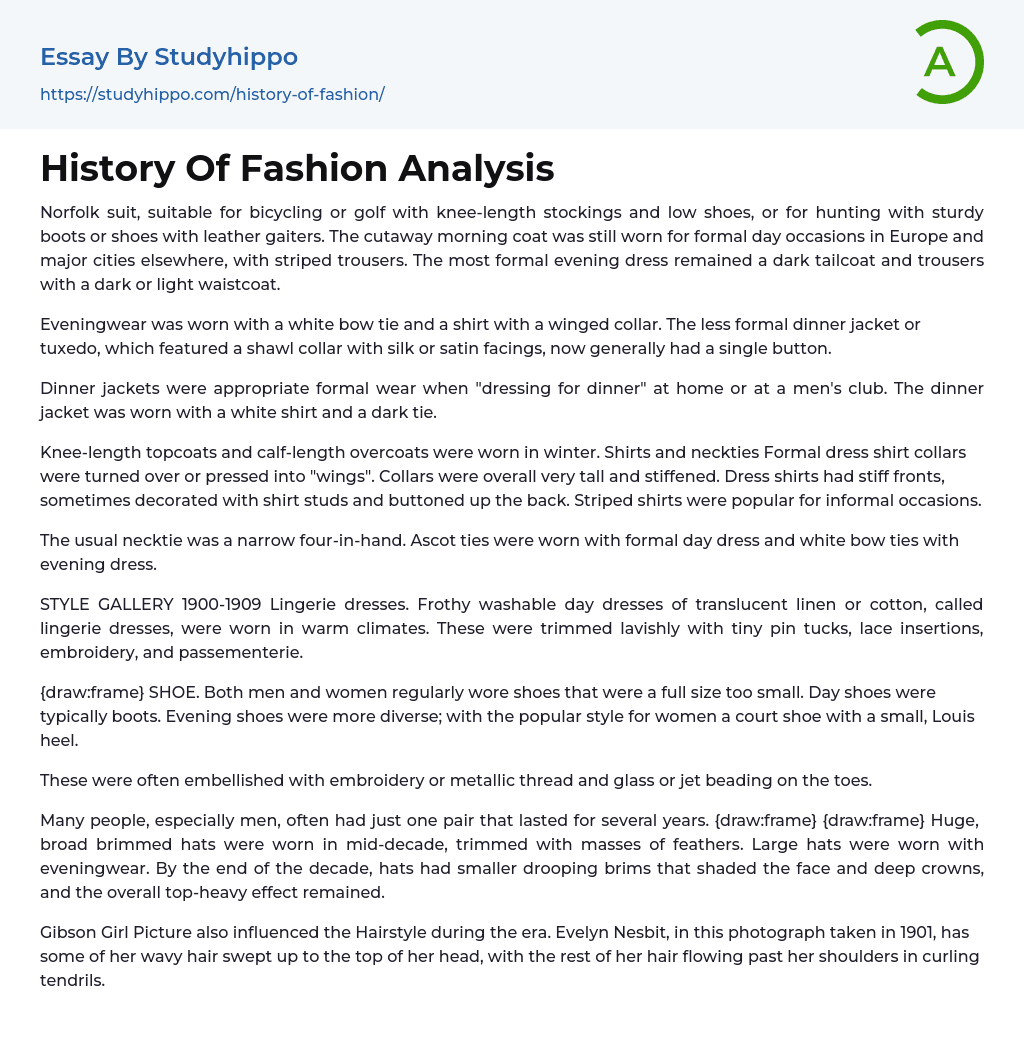Norfolk suit, suitable for bicycling or golf with knee-length stockings and low shoes, or for hunting with sturdy boots or shoes with leather gaiters. The cutaway morning coat was still worn for formal day occasions in Europe and major cities elsewhere, with striped trousers. The most formal evening dress remained a dark tailcoat and trousers with a dark or light waistcoat.
Eveningwear was worn with a white bow tie and a shirt with a winged collar. The less formal dinner jacket or tuxedo, which featured a shawl collar with silk or satin facings, now generally had a single button.
Dinner jackets were appropriate formal wear when "dressing for dinner" at home or at a men's club. The dinner jacket was worn with a white shirt and a dark tie.
Knee-length topcoats and calf-length overcoats were worn in winter. Shirts and nec
...kties Formal dress shirt collars were turned over or pressed into "wings". Collars were overall very tall and stiffened. Dress shirts had stiff fronts, sometimes decorated with shirt studs and buttoned up the back. Striped shirts were popular for informal occasions.
The usual necktie was a narrow four-in-hand. Ascot ties were worn with formal day dress and white bow ties with evening dress.
STYLE GALLERY 1900-1909 Lingerie dresses. Frothy washable day dresses of translucent linen or cotton, called lingerie dresses, were worn in warm climates. These were trimmed lavishly with tiny pin tucks, lace insertions, embroidery, and passementerie.
{draw:frame} SHOE. Both men and women regularly wore shoes that were a full size too small. Day shoes were typically boots. Evening shoes were more diverse; with the popular style for women a court shoe wit
a small, Louis heel.
These were often embellished with embroidery or metallic thread and glass or jet beading on the toes.
Many people, especially men, often had just one pair that lasted for several years. {draw:frame} {draw:frame} Huge, broad brimmed hats were worn in mid-decade, trimmed with masses of feathers. Large hats were worn with eveningwear. By the end of the decade, hats had smaller drooping brims that shaded the face and deep crowns, and the overall top-heavy effect remained.
Gibson Girl Picture also influenced the Hairstyle during the era. Evelyn Nesbit, in this photograph taken in 1901, has some of her wavy hair swept up to the top of her head, with the rest of her hair flowing past her shoulders in curling tendrils.
- Jeans essays
- Russian Empire essays
- Ancient Greece essays
- British Empire essays
- Historical Figures essays
- Nazi Germany essays
- Roman Empire essays
- War essays
- Revolution essays
- 19Th Century essays
- Historiography essays
- History of the United States essays
- 20Th Century essays
- World History essays
- Vikings essays
- Declaration of Independence essays
- Civilization essays
- Evidence essays
- Genocide essays
- Colonialism essays
- Rebellion essays
- 1960S essays
- 1920S essays
- 1950S essays
- Letter from Birmingham Jail essays
- Louisiana Purchase essays
- The Columbian Exchange essays
- World Hunger essays
- What is History essays
- Bravery essays
- Gilded Age essays
- Vladimir Lenin essays
- Alexander The Great essays
- Sparta essays
- Victorian Era essays
- Henry v essays
- Stonehenge essays
- Frederick Douglass essays
- Mahatma Gandhi essays
- Joseph Stalin essays
- Geert Hofstede essays
- George Eliot essays
- Ginevra King essays
- John Keats essays
- Siegfried Sassoon essays
- Ben jonson essays
- Billy elliot essays
- Wilkie collins essays
- John Proctor essays
- Harriet Tubman essays




